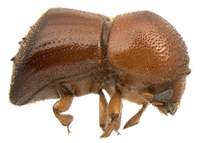Diagnosis
Some of the largest Xyleborini. Elytral declivity always truncated or obliquely truncated, often bearing conspicuous teeth. Large eyes. Pronotal disc of most species asperate. Tibial denticles reduced or absent, tibial edge very uneven, very rugged. Antennal club often tall, appears telescopic.
Distribution
Palaeotropical, uncommon.
Biology
Probably host specific. For example, Immanus colossus, the largest xyleborine, has mostly been found in trunks of Celtis.
Taxonomy
Until recently most species included in Xyleborus or Ambrosiodmus (because of the asperate pronotal disc).
Detailed description
Eyes shallowly emarginate, upper portion conspicuously large. Antennal club tall, "telescopic", club type four (segment 1 small, second and third prominent on both sides). Segment 1 anteriad small, its margin convex, mostly soft, pubescent. Segments 2 and 3 ring-like, corneous, encircling entire club, making it appear telescopic. Segment 1 of antennal funicle shorter than pedicel, funicle 4-segmented, scapus regularly thick. Frons above epistoma rugged, coarsely punctate. Submentum slightly impressed, shaped as very narrow triangle. Anterior edge of pronotum with distinct row of serrations or with an elevated medial carina, sometimes with only a pair of pointed flat serrations. Pronotum from lateral view distinctly tall (type 3), or rounded and robust (type 5), from dorsal view it is rounded (type 1). Pronotal disc with asperities resembling those on frontal slope. Lateral edge of pronotum with pointed shoulder. Procoxae contiguous, prosternal posterocoxal process conical and slightly inflated. No mycangia or associated tufts on pronotum or elytra. Scutellum flat, flush with elytra. Elytral bases straight, with oblique edge, elytral disc as long or shorter than declivity, convex or impressed, "saddle-like", punctures on elytral disc in strial lines or confused. Lateral profile of elytral declivity obliquely truncated, sometimes with lateral costa or carina, sometimes excavated, dorsal profile of elytral apex rounded, or broadened laterally. Posterolateral declivital costa encircling most or all of declivity. Declivity truncated, often with large teeth, or surrounded with robust elevated costa. Declivital surface in some species covered with short dense setae. First interstriae broadened towards elytral summit. Protibiae distinctly triangular, slender on proximal part, broad on distal part. Posterior side of protibia flat, no granules, only setae. Protibial denticles reduced, merged with rugose and uneven protibial edge. Uniformly dark brown or black, in some SE Asian species pronotum much lighter than elytra. Possibly the largest Xyleborini, 7.5-8.8 mm.


